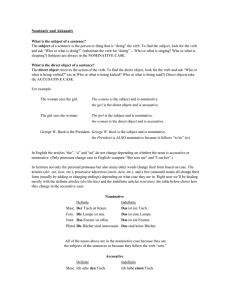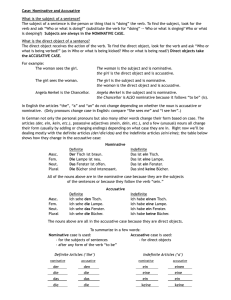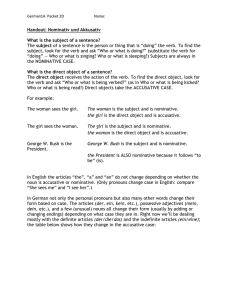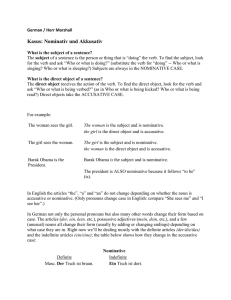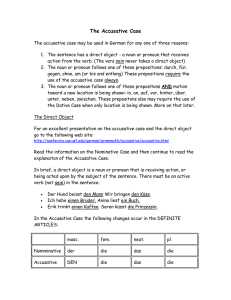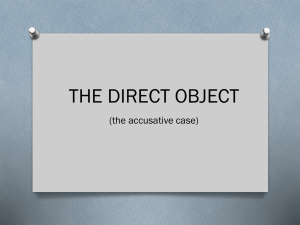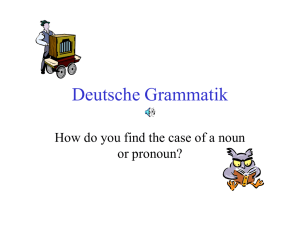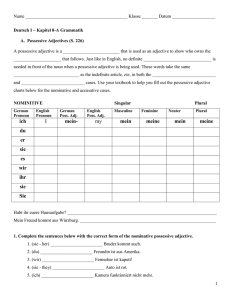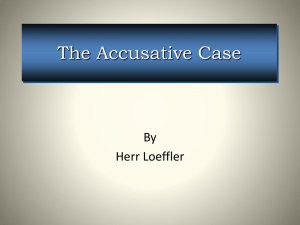Nominative and Accusative
Werbung
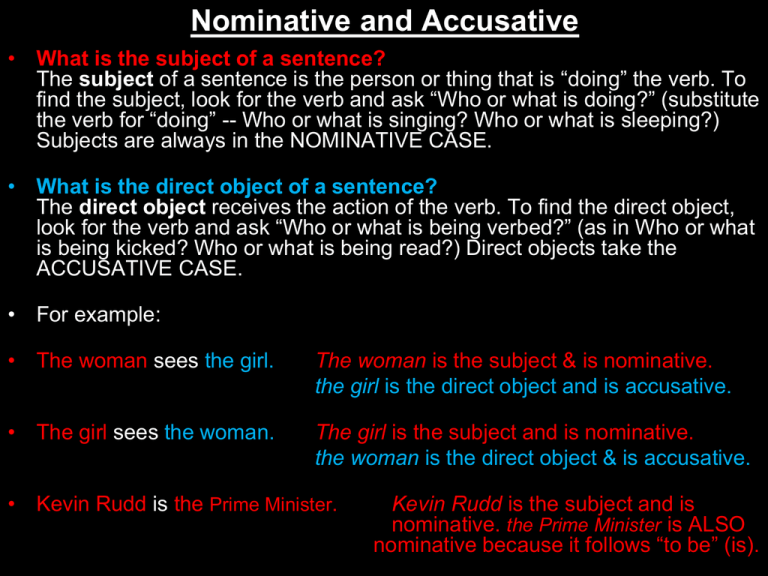
Nominative and Accusative • What is the subject of a sentence? The subject of a sentence is the person or thing that is “doing” the verb. To find the subject, look for the verb and ask “Who or what is doing?” (substitute the verb for “doing” -- Who or what is singing? Who or what is sleeping?) Subjects are always in the NOMINATIVE CASE. • What is the direct object of a sentence? The direct object receives the action of the verb. To find the direct object, look for the verb and ask “Who or what is being verbed?” (as in Who or what is being kicked? Who or what is being read?) Direct objects take the ACCUSATIVE CASE. • For example: • The woman sees the girl. The woman is the subject & is nominative. the girl is the direct object and is accusative. • The girl sees the woman. The girl is the subject and is nominative. the woman is the direct object & is accusative. • Kevin Rudd is the Prime Minister. Kevin Rudd is the subject and is nominative. the Prime Minister is ALSO nominative because it follows “to be” (is). Nominative Masc. Fem. Neut. Plural Der Tisch ist braun. (The table is brown.) Die Lampe ist neu. (The lamp is new.) Das Fenster ist offen. (The window is open.) Die Bücher sind interessant. (The books are interesting.) Masc. or Das ist der Tisch. (That is the table.) All of the nouns above are in the nominative case because they are the subjects of the sentences or because they follow the verb “sein.” Accusative Masc. Ich sehe den Tisch. I see the table. Ich habe einen Tisch. I have a table. Fem. Ich habe eine Lampe. I have a lamp. Ich sehe die Lampe. I see the lamp. Neut. Ich sehe das Fenster. I see the window. Ich habe ein Fenster. I have a window. Plural Ich sehe die Bücher. I see the books. Ich habe keine Bücher. I have no books. The nouns (in blue) above are all in the accusative case because they are direct objects. To summarise in a few words: Nominative case is used: - for the subjects of sentences - after any form of the verb “to be” Accusative case is used: - for direct objects (the thing being hit, being read, being had) - after accusative prepositions Table Summary: Nominative Accusative Dative Masculine Feminine Neuter Plural der ein die eine das die ein keine den die das die einen eine ein keine dem der dem den einem einer einem keinen Some more examples: • Ich schlage meinen Bruder. • I hit my brother. • Ich frage den Lehrer. • I am asking the (male) teacher. • Meine Mutter liebt mich. • My mum loves me. Remember: pronouns change in the accusative case too! Nominative ich I Accusative mich me du you dich you er he, it ihn him, it sie she, it sie her, it es it es it wir we uns us ihr you (plural) euch you (plural) sie they sie them Sie you (formal) Sie you (formal) Circle all nouns in the nominative, and underline all nouns in the accusative. them on Tuesday. 1. I meet them 2. He plays the piano. 3. They invited me. 4. Run Lola Run is a German movie. 5. Paul hit the ball. 6. I am sleeping. 7. Martin and Petra like books. 8. Is that a Mercedes? 9. Have you seen a Shakespeare play? 10. Donald owns a hotel and a car. Und jetzt ihr! (and now you!) 1. I meet them on Tuesday. 2. He plays the piano. 3. They invited me. 4. Run Lola Run is a German movie. 5. Paul hit the ball. 6. I am sleeping. 7. Martin and Petra like books. 8. Is that a Mercedes? 9. Have you seen a Shakespeare play? 10. Donald owns a hotel and a car. Now practice identifying subjects and objects in these German sentences. 1. Er hat ein Buch. Er Objekt = _______ Buch Subjekt = ________ 2. Ich trinke Kaffee. Ich Objekt = _______ Kaffee Subjekt = ________ 3. Martin kauft CDs. Martin Objekt = _______ CDs Subjekt = ________ 4. Peter hat den Stift. Peter Objekt = _______ Stift Subjekt = ________ 5. Herr Schmidt trinkt eine Cola und ein Bier. Cola & Herr Bier Schmidt Objekt = _______ Subjekt = ________ 6. Unsere Großeltern sprechen Deutsch. Deutsch Subjekt = Großeltern ________ Objekt = _______ •Firstly, use a dictionary to find out the case of these nouns. Put a m, f or nt in the brackets at the end of each sentence. •Then, fill in the appropriate forms of the, a, my & no/not any (you choose which word to use). Translate each sentence into English. •Remember: a direct object is having something done to it. Eg: Ich habe einen Apfel. (m) I have an apple. einen Wagen. (_____) m 1. Wir kaufen _________ 2. Ich nehme _________ Zeitung. (_____) 3. Wir sehen _________ Hund. (_____) 4. Wir besuchen _________ Mann. (_____) 5. Du brauchst _________ Buch. (_____) 6. Ich lese _________ Uhr. (_____) 7. Sie treffen _________ Freundin. (_____) 8. Jane bekommt _________ Brief. (_____) 9. Ich fahre _________ Motorrad. (_____) 10. Bob hat _________ Auto. (_____) Antworten 1. Wir kaufen einen Wagen. (m) We buy a car. 2. Ich nehme eine Zeitung. (f) I take a newspaper. 3. Wir sehen einen Hund. (m) We see a dog. 4. Wir besuchen einen Mann. (m) We visit a man. 5. Du brauchst ein Buch. (nt) You need a book. 6. Ich lese eine Uhr. (f) I read a clock. 7. Sie treffen eine Freundin. (f) They meet a (female) friend. 8. Jane bekommt einen Brief. (m) Jane receives a letter. 9. Ich fahre einen Motorrad. (m) I drive a motorbike. 10. Bob hat ein Auto. (nt) Bob has a car.
